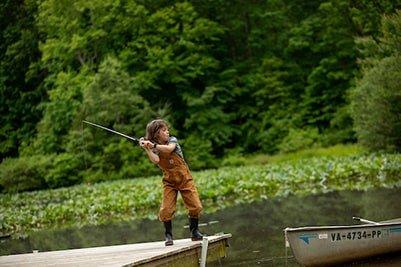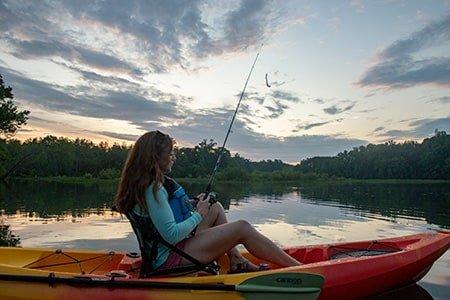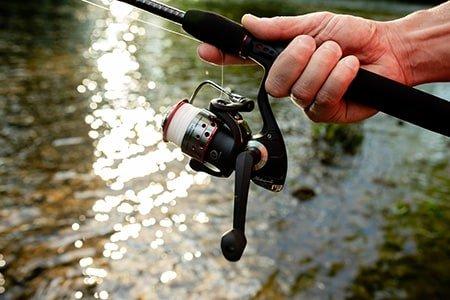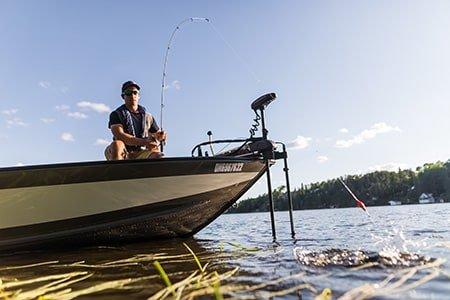How To Cast Properly

One of the fundamental parts of fishing is merely casting your bait or lure into the water. It is an often-overlooked part of fishing, but it is crucial to get your bait out as far as possible or as close as you can to fish-holding cover.
Just like swinging a baseball bat or throwing a football, casting properly requires some initial practice before becoming second nature.
There are a few different factors that go into making the right cast and one of the first things to consider is the type of reel you are using. Another thing to take into consideration is the weight of your lure, whether you are fishing from the shore or a boat, and obstructions around you.
Overhanded Casting

The overhand cast is the most common way to sling a lure or bait into the water. It is also the best way to get maximum distance, making it an essential skill in fishing.
A great cast should be angled to get the best possible trajectory. Aiming too high will result in a broad arc, like a rainbow, and will hurt your distance. Waiting too long during your casting motion will result in much shorter casts.
Getting the right distance and accuracy are essential things to consider when casting properly and change based on the type of reel you are using.
Spincast and Spinning Reels

Both of these types of reels are straightforward when it comes to casting. The line comes freely off of the spool and will achieve distance based on how hard you throw.
Spincast reels are engaged by pushing a button and anglers let go of the button during the casting motion. The timing of this step is crucial as it will affect how fast you cast. Releasing the button at the 10 or 11 o’clock position will generate the best distance.
Spinning reels are similar to spincast, but instead of engaging a button, anglers flip over the bail and hold the line with a forefinger. Use the same principles as casting a spincast reel and release the line at the same position for the best results.
Basitcast reels are trickier to cast and require your thumb to slow the trajectory of your bait or lure before it hits the water. The same motion of casting a spinning or spincast reel holds, but anglers have to slow the reel’s spool or result in a backlash. This occurs when the spool continues to spin after the lure reaches the water and causes loose line that can become tangled inside of the reel.
While they can prove challenging at first, baitcast reels can obtain excellent casting distance and can handle just about any lure, line, and fish size.
Other Types of Casts

For most fishing, a simple overhand cast will suffice and it is the best way to cast a long distance. Depending on what is around you, you may need to watch for overhanging trees or other anglers standing behind you on a boat.
In these instances, a sidearm cast may be necessary to avoid hitting anything with your bait. The same principles as an overhand cast apply, but generally, you will not be able to achieve the same casting distance. But, sometimes, a sidearm cast is the only way to go.
Other types of casts include a roll cast that is designed for short-quarters fishing when casting to targets. Roll casts are just like they sound and are made with a quick rotation of the rod during the cast.
The same goes for two other presentations known as flipping and pitching in bass fishing; they can present lures with high accuracy. Both of these techniques are more of an underhanded swinging pendulum and are best for shorter distances.
All of these casts require practice to perfect but allow for extreme accuracy to cover and allow anglers to make quiet presentations into the water.
There is no one single universal cast and learning several types will make you a more rounded angler and ensure that you are ready for anything.
How a Rod Affects Casting

Another factor of casting is the rod used. Shorter rods generally cast much more concise, while longer rods can aid in getting more distance. The power and action of a rod also come into play as the bend in a rod can increase casting distance.
The other way that a rod changes things is the length of the rod’s handle. A longer rod handle allows users to make two-handed casts, with one hand near the rod butt and the other on the reel. Doing this will enable anglers to maximize the exertion of the cast and helps to increase distance.
Shorter rod handles or those with pistol grip style handles make it more challenging to use this method but makes it easier to make short roll casts and sidearm deliveries.
Learning to cast properly is something that takes time to master, but can significantly help to increase your odds of catching more fish. A good idea is to practice with a weight or casting plug in your backyard. Taking some time to master the perfect cast for your rod and reel combination will make sure you are ready when you hit the water.